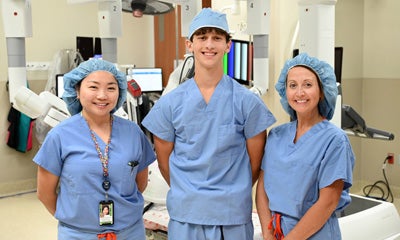Enlarged kidney
When John Evans got injured during a school wrestling match, he and his family expected an MRI to find that he had experienced a herniated disc, but what came as a complete surprise was another diagnosis: he also had an enlarged kidney. “When they called with the results, we were shocked,” his mother, Mary, shared. “We had no idea there was anything wrong with John’s kidney. We never had any reason to suspect it, because he never had any pain or symptoms.”
John was referred to Children’s of Alabama, specifically to Carmen Tong, D.O., a pediatric urologist and the director of robotic surgery at Children’s. Dr. Tong ran further tests and discovered that John’s enlarged kidney was a congenital anomaly. His ureters weren’t anatomically correct—one of them was positioned on top of his kidney. Normally, ureters are at the base of the kidney. “The incorrect placement of the ureter meant that it wasn’t filtering properly,” Mary said. “From that, we knew that surgery unfortunately would be required to fix it, because it would one day turn into a problem if nothing was done.”
Typically, this sort of procedure would require a more invasive surgery. Luckily for John, just a few months prior, Children’s of Alabama had acquired a new surgical robot, the da Vinci surgical robot, a piece of equipment that, according to Dr. Tong, “completely changed the landscape of minimally invasive surgery.” The da Vinci better mimics the movement of a surgeon’s hands, is less invasive and less disfiguring. “Typically, kidney surgery would require a long incision, particularly for adolescents and teens, and recovery is typically more arduous because of that,” Dr. Tong explained. “The da Vinci, however, is a gamechanger. It offers a three-dimensional view, which allows me as the surgeon to ensure the instrument’s movements are much more exact and precise, which is needed especially when operating on children. The da Vinci also requires smaller incisions, which makes the recovery process much simpler and more straightforward.”
When Dr. Tong presented the new robotic surgical option to John and his family, they immediately knew it was the right decision. “Dr. Tong sat with us and drew out what his kidney looked like, what it should look like, and how she could repair it with the surgical robot,” Mary explained. “Once we met with her, we wanted no one else. She made it seamless.”
Through just a few small holes in his stomach, Dr. Tong was able to correct John’s kidney, and he spent only one night in the hospital after the surgery. “He was home from school for a week, and he had to refrain from exercise for a few weeks before getting back to weightlifting and football, but that’s it,” Mary said. “It was so much quicker than the alternative, because had they done the typical surgical procedure, he would have been out recovering many more weeks.”
After sitting out for his short recovery time, John was able to get right back into football, and he’s been healthy ever since. “We never even knew this issue existed until the MRI, but we are so thankful that it was caught before John had any problems and that Dr. Tong was able to correct it in a way that made the entire process so much easier on him,” Mary said. “Dr. Tong was amazing throughout the entire process, making both John and us comfortable with everything. We’re so thankful to have had her as John’s surgeon.”











